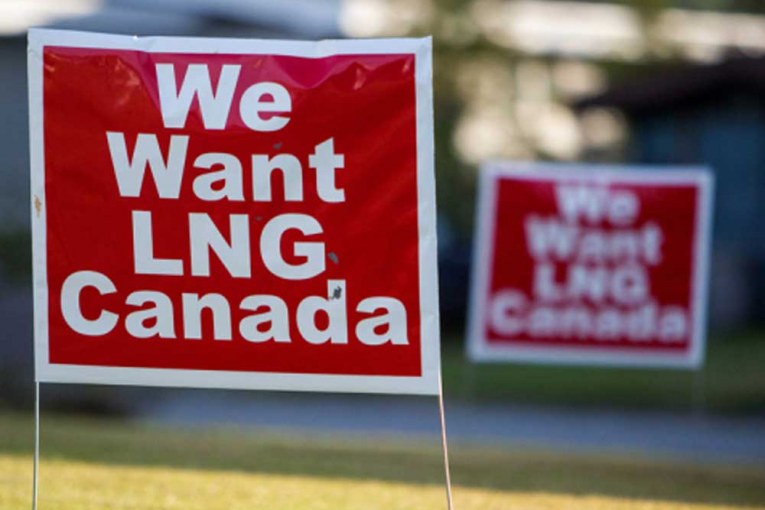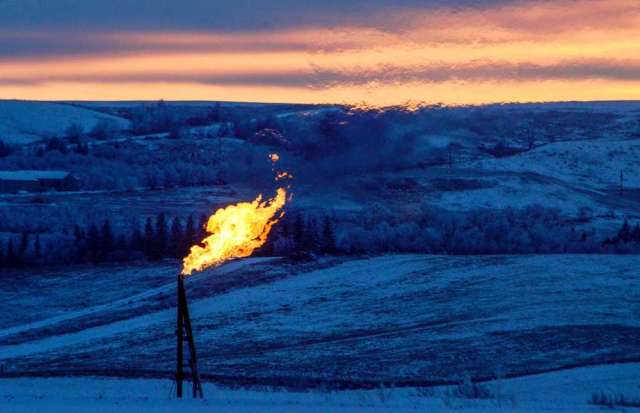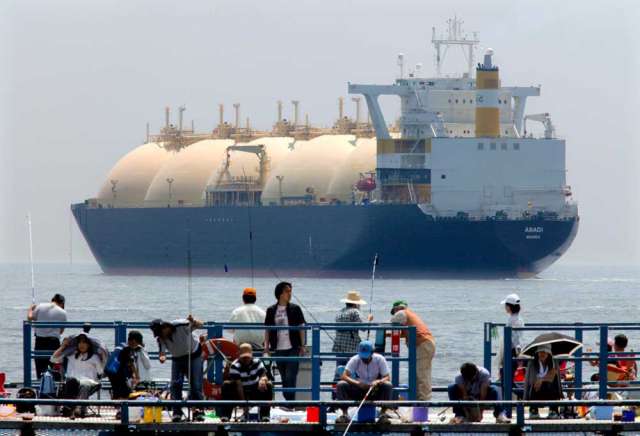
Marty Proctor and his team at Calgary-based natural gas producer Seven Generations Energy Ltd. have worked for years to find an easier way to send their gas to more lucrative markets overseas.
Right now, the company sends its gas from wells near Grande Prairie, Alta., 3,000 kilometres southeast to Chicago, before it changes pipelines and travels another 1,700 clicks to Louisiana, where it is refrigerated at -160 C at an liquefied natural gas facility along the Texas border. That temperature is when the gas reaches a liquid state and can be loaded onto ships bound for Europe and Asia.
The long, roundabout journey has been a profitable way for Seven Generations to market 100,000 cubic feet of natural gas per day for the past three years. But overseas natural gas markets have collapsed in recent months, which has put pressure on other markets around the world as well.
The ability to raise funds, to get partners to join us, is challenged by the global situation
Marty Proctor, chief executive of Seven Generations
“It’s a huge surprise that the price at Henry Hub is poor, but it’s even worse in Europe right now,” Proctor, chief executive of Seven Generations, said.
The coronavirus pandemic has knocked down demand for power worldwide, with Wood Mackenzie analysts expecting a 2.7 per cent contraction in global LNG demand, marking the first time in eight years that demand for the commodity has fallen.
The market chaos is also frustrating Seven Generations’ efforts to find a shorter route for its natural gas to liquefaction facilities and overseas markets. The company in 2016 bought a stake in an early-stage LNG project on Vancouver Island called Steelhead LNG. It then partnered with nine other gas producers to form Rockies LNG, a consortium looking to build a project in northern British Columbia.
But Canadian LNG export projects have been delayed multiple times and are now encountering difficulties finding joint-venture partners, financing and off-take agreements to underpin construction. With few options to access capital, LNG proponents are asking the federal and provincial governments to help as part of an economic stimulus package to re-start the country’s economy following COVID-19.
If help isn’t forthcoming, the domestic natural gas industry’s dream of building multiple LNG export facilities in Canada — rather than using LNG projects 4,700 kilometres away — could be delayed yet again, leaving the country dependent, once again, on a single export market, the United States, which increasingly doesn’t need Canadian gas as American companies are swimming in so much of their own gas that they’re burning it off with flares across North Dakota and Texas.

“There probably aren’t much better prices to be had where we can access them right now,” Proctor said.
The U.K. National Balancing Point benchmark price for natural gas averaged just US$1.67 per thousand cubic feet for the full day Thursday, according to AltaCorp Capital data, which was 15 cents less than the Henry Hub benchmark in Louisiana, a place with plentiful gas and access to more from across the continent.
In Japan, the largest LNG importing country in the world, the price of LNG has fallen to US$2.34 per mcf, which is higher than the Henry Hub benchmark at US$1.81, but well below the cost to liquefy gas and send it across the Pacific Ocean.
As a result, U.S. exports of LNG have fallen 37 per cent in a matter of months.
But despite the global pricing dynamics, Proctor said his company continues to sell 100,000 cubic feet per day to Houston-based Cheniere Energy Inc. for export to foreign markets. He said the company receives Henry Hub benchmark prices for its gas and, therefore, is not exposed to the lower prices in Europe and elsewhere.
Other companies have cancelled contracts to chill their gas at various LNG facilities on the U.S. Gulf Coast.
20 LNG cargo sailings had been cancelled since commodity prices plunged in March
For example, Cheniere, the largest LNG exporter in the U.S., confirmed in a May earnings call it had been paid US$50 million in cancellation fees after overseas prices crashed.
“As global markets remain weak, we have had customers elect to cancel some additional cargoes,” Cheniere chief executive Jack Fusco said on the call, though he declined to quantify the volume of cancellations.
Wood Mackenzie research director Robert Sims in a June 2 research note said more than 20 LNG cargo sailings had been cancelled since commodity prices plunged in March, which is “significant for the market” and U.S. LNG terminals would be under-utilized for months, potentially into 2021.
But while existing facilities, including Cheniere’s in Sabine Pass and Corpus Christi, are dealing with cancelled contracts, projects that are still trying to raise money and find partners are also struggling.
“The ability to raise funds, to get partners to join us, is challenged by the global situation,” Proctor said of Rockies LNG, the consortium considering building a facility near Kitimat, B.C.
The Canadian natural gas industry’s dreams of export projects on the West Coast have been repeatedly delayed. A decade ago, there were more than 20 projects proposed for construction in B.C., but the vast majority of those have been dropped or indefinitely delayed by their owners.
Last month, the only LNG project to break ground in the country during that time, the $40-billion LNG Canada project led by Royal Dutch Shell PLC, celebrated the first weld at its terminal near Kitimat.
The few remaining Canadian LNG proponents said there have not been any impacts on the contracts they’ve already signed, but the market turmoil and COVID-19-related economic lockdowns have once again postponed their previously scheduled construction timelines.
“We’ve had no issues with existing contracts. This is a long-term view. We’re not going to make a significant investment decision based on the spot price of LNG moving into Asia,” said David Keane, president of Woodfibre LNG Ltd., which has been working to build a $1.6-billion liquefaction facility near Squamish, B.C.
The company had planned to reach a final investment decision last year, but its engineering and procurement contractor was pushed into receivership, and that combined with the lockdowns has pushed the company’s planned date to make a decision on the project all the way to May 2021, Keane said.
“Projections are that demand for LNG will continue to grow considerably,” he said, adding that the company remains committed to building the facility to export Canadian gas to Asian markets despite current market challenges.

Natural gas producers were shipping 37 per cent less gas to LNG facilities in the middle of the pandemic, according to a report by IHS Markit in May. The market researcher also said deliveries of gas to LNG facilities fell to six billion cubic feet per day in mid-May, from 9.5 bcf/d in March.
“We are witnessing an historic event where U.S. LNG is taking on the new role of swing supplier,” IHS Markit executive director Terrell Benke said in the report, using a term for commodity producers that have a combination of spare capacity and a cost structure that allows them to ratchet output up and down depending on market forces.
We are witnessing an historic event where U.S. LNG is taking on the new role of swing supplier
IHS Markit executive director Terrell Benke
Many facilities on the U.S. Gulf Coast, including those built and operated by Cheniere, run a tolling operation: They charge natural gas producers to liquefy at their facility, and have the flexibility to scale back when those producers choose to do so, though the producers need to pay cancellation fees.
By contrast, many other projects globally have integrated supply chains, from the natural gas well head to the liquefaction facility and export terminal, a process that inherently has higher fixed costs throughout the value chain.
Many of the smaller LNG proposals in Canada, including Woodfibre and Rockies LNG, are being advanced with this type of integrated business model.
Canadian gas producers believe toll-based LNG facilities grab too much of the value in the gas exporting supply chain. Seven Generations’ Proctor said part of the desire to build the Rockies LNG project is to allow producers to capture more margin for their gas.
“These times of low prices really amplify the disparity in the value chain, and who’s getting the value for our gas,” he said.
Similarly, Birchcliff Energy chief executive Jeff Tonken, in an interview with the Financial Post in April, said the tolling model includes too many embedded costs.
“The economic rent that’s leaving doesn’t make the project feasible. You’re way better off to drive a project. That’s what we’re trying to do,” he said, noting that Birchcliff is providing office space within its existing headquarters for Rockies LNG to do its work and save money.
Rockies LNG is looking for partners, but also appears to be going through a shakeup. Greg Kist, up until recently president of the company, informed the Financial Post this week he’s no longer with the company.
Cameron Gingrich, director, strategic energy advisory at Solomon Associates Canadian, said LNG project backers face another challenge in the current price-challenged market: finding enough customers to buy their future gas since they need those contracts to finance the billions of dollars it costs to build a new facility.
Gingrich said many of the largest utility consumers in Asia have already signed contracts for their LNG needs in the long term, leaving just “tier 2 secondary players” that are less creditworthy.
“It’s very hard to invest a billion (dollars) into the credit and contracting there,” he said.
Financing difficulties would likely delay any construction start date for LNG projects in Canada, but economic stimulus packages being prepared across the country could change that.
“If you had the government, the Development Bank of Canada, helping to bridge the gap between the credit these smaller Asian consumers have, that could help these guys spur investment in the LNG facility,” Gingrich said.
Pieridae Energy Ltd.’s Goldboro LNG project, which, if built, would take natural gas from Alberta to a $10-billion facility on the Nova Scotia coast, is one project that is actively seeking government assistance to reach a final investment decision.
“We are selling our idea to government that this is the time for the government to be brave about something,” Pieridae chief executive Alfred Sorenson said.
The company has already delayed its expected final investment decision and now hopes to announce construction starting in June 2021.
Before then, Sorenson said, Pieridae expects to do some initial site preparation work and is actively speaking with governments in Nova Scotia, Alberta and Ottawa about funding.
“Pieridae can’t do this on its own,” he said.
• Email: [email protected] | Twitter: geoffreymorgan
You can read more of the news on source
